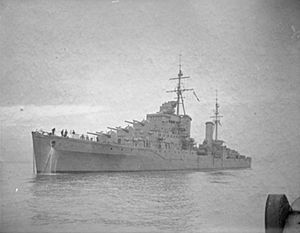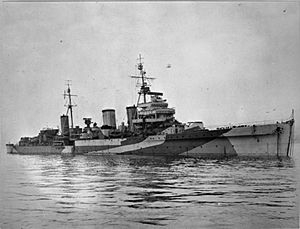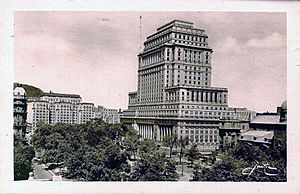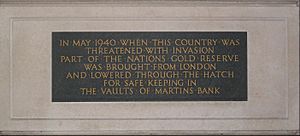Operation Fish facts for kids
Quick facts for kids Operation Fish |
|||||
|---|---|---|---|---|---|
| Part of Second World War | |||||
 HMS Bonaventure was forced to remain stationary for a time to protect a treasure ship |
|||||
|
|||||
| Belligerents | |||||
| Casualties and losses | |||||
| 0 ships sunk | |||||
Operation Fish was a top-secret mission during World War II. It involved moving a huge amount of wealth, mostly gold, from the United Kingdom to Canada. This was done to keep Britain's money safe from Nazi Germany if the UK was invaded. It was one of the biggest movements of wealth ever known in history.
Contents
Why Britain Moved Its Gold
In September 1939, the British government made a rule. Everyone in the UK had to tell the Treasury about their valuable papers, like stocks and bonds. Even before Operation Fish officially started, ships were already carrying gold and money. This money was used to buy weapons from the United States.
First Secret Gold Shipments
One early mission involved Commodore Augustus Agar. His ship, HMS Emerald, arrived in Plymouth, England, on October 3, 1939. Agar received secret orders from Rear-Admiral Lancelot Holland.
The orders said that two million pounds in gold bars would be loaded onto each ship. Each gold bar weighed about 130 pounds. Guards were placed on the railway trucks carrying the gold. The loading started at dawn, and every box was carefully watched.
On October 7, 1939, Emerald sailed from Plymouth. It carried gold from the Bank of England. The gold was going to Montreal, Quebec, Canada. It would be used to pay for American war supplies. To keep the mission secret, the crew wore "tropical white" uniforms. This was meant to confuse German spies.
Emerald sailed with other ships, including the battleships HMS Revenge and HMS Resolution. Her sister ship HMS Enterprise and the old cruiser HMS Caradoc also joined. They faced very rough seas. By the time they reached Halifax, Nova Scotia, Emerald had lost some of its equipment. This included boats, rafts, and even its spotter plane, a Fairey Seafox.
Protecting Britain's Future
Winston Churchill became the leader of Britain. He wanted to make sure Britain could keep fighting even if the UK was taken over. He planned to send British wealth to the safety of Canada.
The government used its wartime powers. They took the valuable papers that people had registered earlier. These were secretly moved to the port of Greenock in Scotland. Men who had sworn to secrecy loaded the wealth onto the Emerald-class light cruiser HMS Emerald.
The ship left on June 24, 1940, with several destroyers as escorts. Another fierce storm hit them. The high seas forced the ships to slow down. This made them easy targets for any U-boats (German submarines). They finally reached Halifax on July 1, 1940. The British treasure was then put on trains. The gold went to Ottawa, and the valuable papers went to the Sun Life Building in Montreal.
More Treasure Convoys
Another Operation Fish convoy sailed on July 5, 1940. It had five ships loaded with a huge amount of money. This was the largest movement of wealth in history. Offshore, they met their escort, which included the battleship HMS Revenge.
Trouble started when one ship, the Polish Batory, had engine problems. It had to leave the convoy. Only HMS Bonaventure stayed to escort it. The two ships then ran into heavy fog. Because of the danger from icebergs, they had to stop. This made them easy targets for U-boats. Eventually, repairs were made. Both ships made it to Halifax days after the other treasure ships.
Where the Treasure Was Stored
The British valuable papers were kept in a special underground vault. This vault was built quickly, three floors below the Sun Life Building in Montreal. The Royal Canadian Mounted Police guarded it day and night.
A rumor was spread on purpose in Montreal. It said that the Crown Jewels of the United Kingdom were stored there. This helped explain why there was so much activity at the building. A very secret group called the United Kingdom Security Deposit worked in the vault. They sold Britain's valuable papers on the New York Stock Exchange over the next few years. This money helped pay for Britain's war costs.
The 5,000 employees of Sun Life never knew what was in their basement. Not one crate of cargo went missing during unloading. Even though thousands of people were involved, German spies never found out about the operation. Many government accountants and bankers worked hard to list everything in the thousands of crates. They found that a huge amount of money had been shipped from the UK to Canada. Not one gold bar was lost.
Remembering the Mission
A stone plaque is on the outside wall of Martins Bank in Liverpool. It remembers the gold stored there on its way to Canada. It says: "In May 1940 when this country was threatened with invasion part of the nation's gold reserve was brought from London and lowered through the hatch for safe keeping in the vaults of Martins Bank."
Operation Fish in Stories
The 1993 BBC drama The Bullion Boys shows the 1940 transport of Bank of England gold to Canada through Liverpool. It also tells a story about Liverpool dock workers trying to steal some of it.
See also
- Gold reserves of the United Kingdom
- Flight of the Norwegian National Treasury
- Moscow gold (Spain) – gold reserves sent by Republican Spain to the Soviet Union during the Spanish Civil War
- Romanian Treasure, gold reserves sent (alongside other valuables) by Romania to Russia for safekeeping during World War I, but never returned




